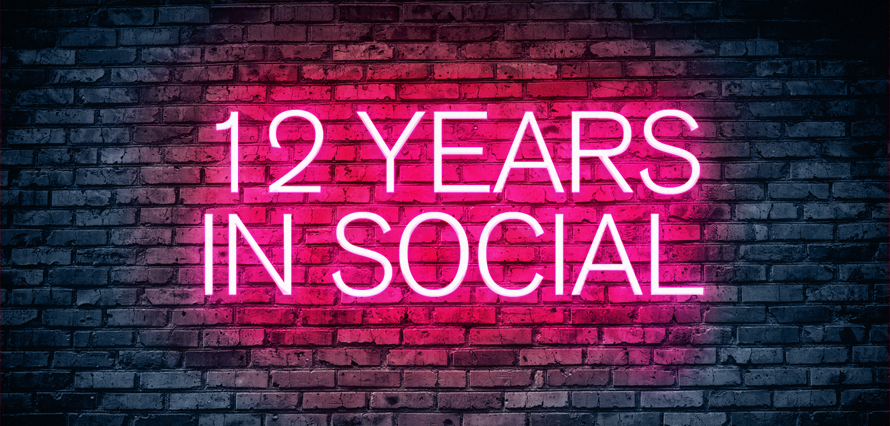May 17, 2016

So last week immediate future turned 12 years old. That’s 12 years we’ve been working with brands in social media – it doesn’t seem possible does it? Surely social media didn’t exist back then?
OK, it wasn’t called ‘social media’ in 2004. It was working with bloggers, Flickr, LinkedIn and MySpace to communicate with an early adopter audiences. Twitter and Facebook were but a twinkle in the eye of the internet. Since then it has been a rollercoaster of a ride. The social media landscape has changed so much and the change comes faster and faster every year.
Of course, we wouldn’t change a thing about the journey. The teams here at immediate future have learnt every step of the way. Not just new technologies, but new ways of communication, of reaching out to customers. It is thrilling, scary and amazing all at the same time.
Enough with the nostalgic reminiscences! The value of all these years in social media, is in the lessons we have learnt and the best practices we’ve honed. So let me share a few…
You have to be serious about social if you want to have impact
In 2006 we used Twitter for the first time. Not because it had any significant reach. It didn’t. But because it was a way to send an SMS message to bloggers and journalists for free. Things were simple back at the start of social.
Now of course, the world has got a whole lot noisier as billions of tweets and post go out every day. Marketers battle to gain cut-through, work hard to prove value in a constantly changing landscape. Social media marketing is more complex. It means brands need to be sophisticated in their approach.
There is little value in chasing vanity metrics, or using a platform, just because of its clever technology (or worse still, because it is new and shiny). Being serious about social requires a strategy (not just smart execution).
And, don’t groan, you have to invest in social media. Not only invest in resource, from creative skills to community management. You need to spend in paid social too.
If you want to be social-first, be serious about social. Get your budgets right, your resources in order and your strategy in place. And you will get results. We know that. We can demonstrate that.
Everything keeps changing, but it also stays the same
Boy do we know how fast social media can change. Some weeks it seems as if it’s all happening at once. We get sign-off on a plan, just to have it change overnight as the platforms revises algorithms, removes buttons or the changes the rules – often without notice. We are used to being agile and moving fast. Audiences change rapidly too. They hop between platforms, they get behind new trends and every month you can discover more about them as data analytics gets better and better.
Yes we love the speed of change at immediate future. Yet some things stay the same. Good process are essential. And many of these processes are the same or similar to all good marketing processes. There is still a need to focus on the customer journey, develop audience personas and map funnels. Old world marketing has adapted, but it is, at its core, the same
People are still people. When social started it was so new and shiny that a lot of terrible content got traction. Of course that is no longer the case. People are savvy. Your audience want to see interesting material, great copy, and amazing visuals. Or they will ignore you. Marketers need to be smart with their messaging, smart with content and plan in the same way you would plan a big TV or out of home campaign. There is no room anymore for your social communications to be owned by interns or for your content to look like its duct taped together as an afterthought.
Fashions, trends and ideas spin around and around.
When we started in social the main focus was influencer relations. All those wonderful bloggers adding their voices to the brand. It was exciting and new. By 2008 the world had moved on. Influencer relations dropped into the background. And in 2009 Facebook launched the ‘like button’, and brands dashed to attract likes and followers. Of course, now these vanity metrics have minimal value when compared to ROI and attributed metrics that move the needle on value. Again social has evolved.
This year we have seen the revival of the influencer. Admittedly a new type of influencer. From Instagram to Snapchatters, we are seeing a new breed of ‘visual’ influencer. There are more of them (and I don’t just mean the celebrity YouTubers). They might not always have mass reach, but they change behaviours. A crucial element for many marketers when trying to affect brand perception.
Ideas, methods and approaches seem to return to social media every few years. Nothing quite gets thrown out. So keep all your ideas and lessons learnt, you may just have an opportunity to use them again
It’s the journey!
One last point. In case it wasn’t clear from the start. Working with brilliant brands to use social media to get close to customers and deliver marketers the return they need is a passion of ours. The last 12 years has been an adventure. Always being kept on our toes, challenging marketing principles, educating colleagues and brands. It is such a buzz. We are not at the end of this journey. But it is not the end that inspires us, it’s the journey that drives our passion. We are enjoying the ride!
Here’s to the next 12 years!